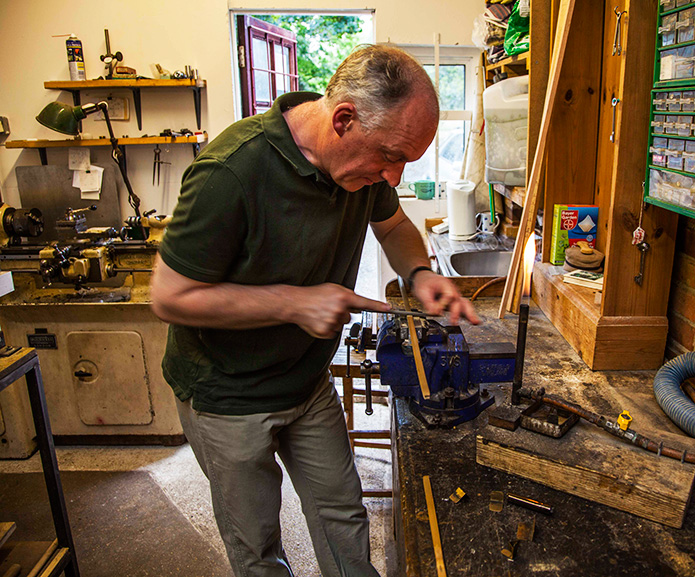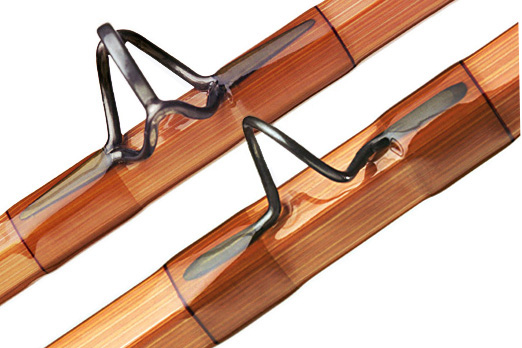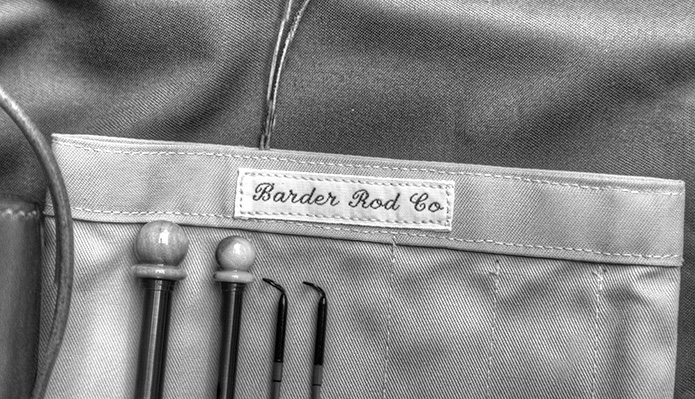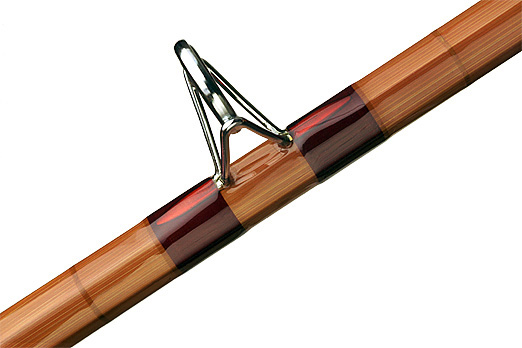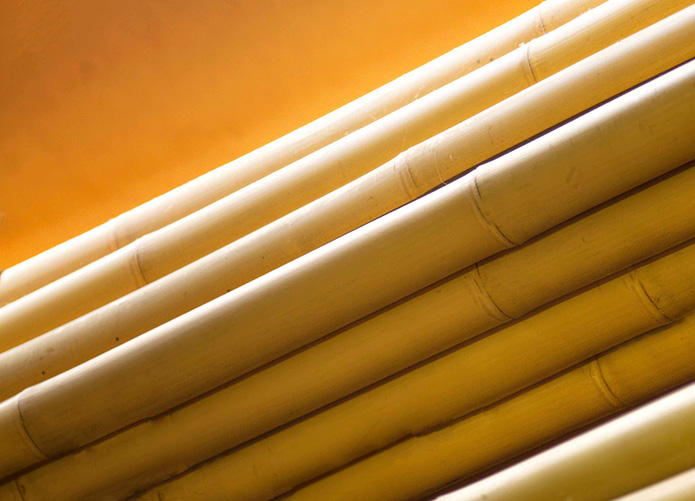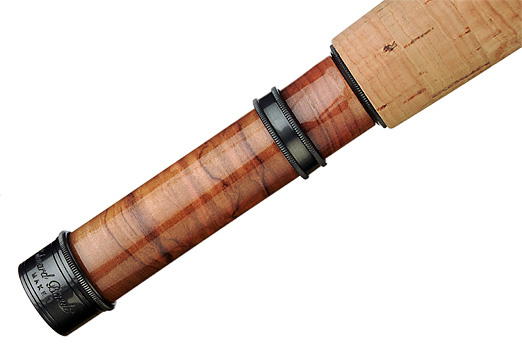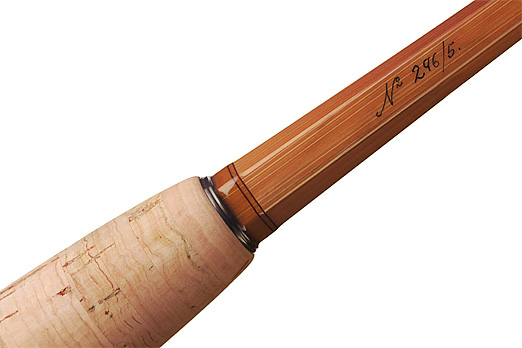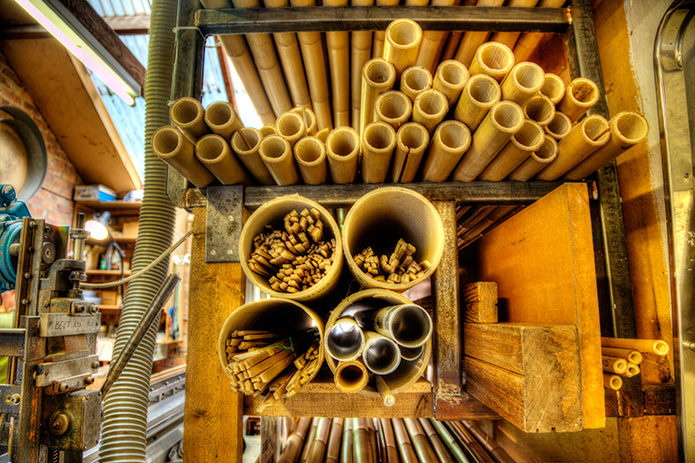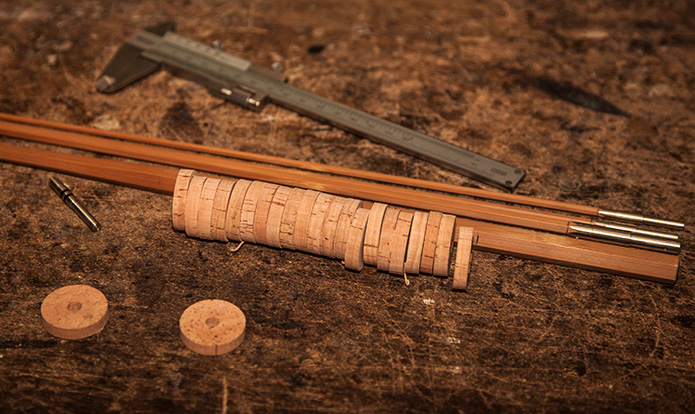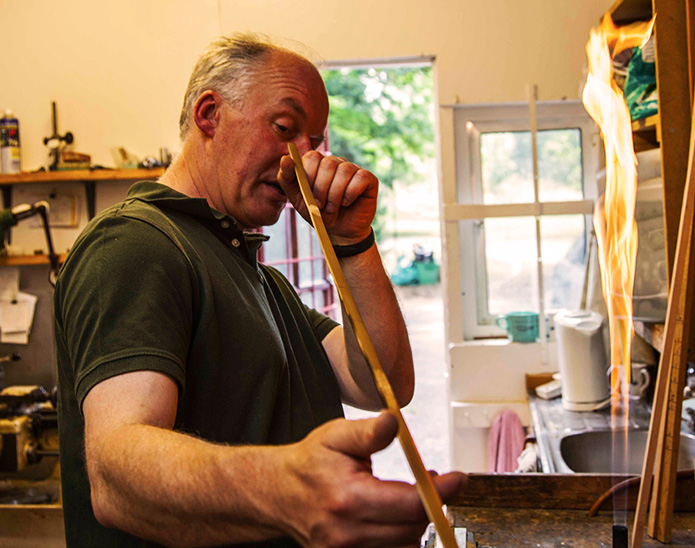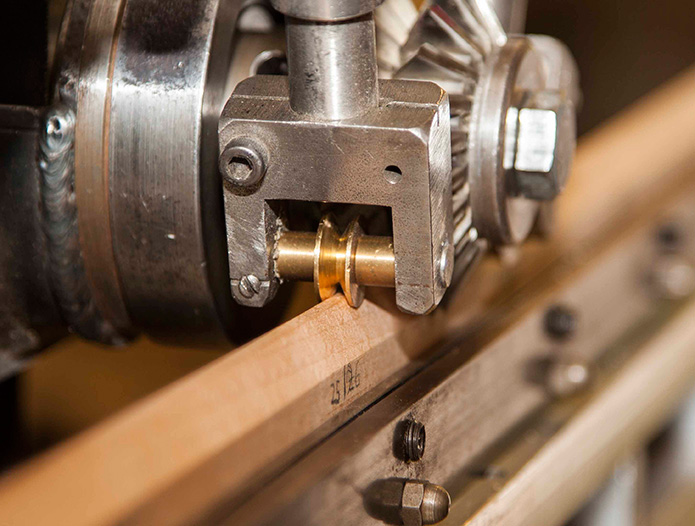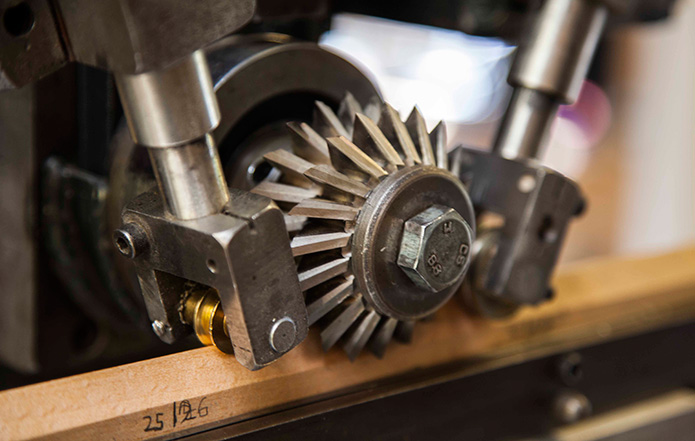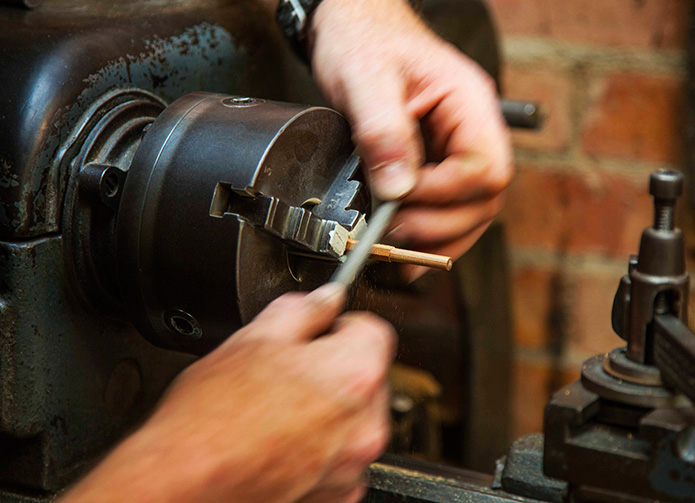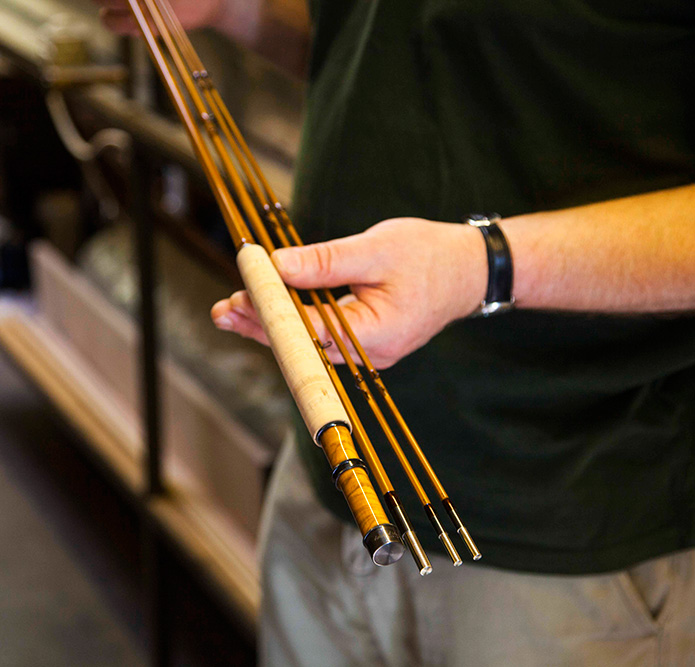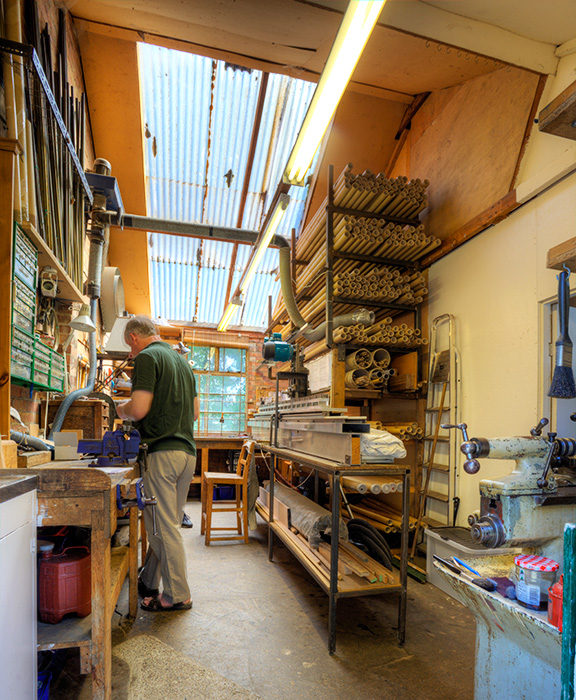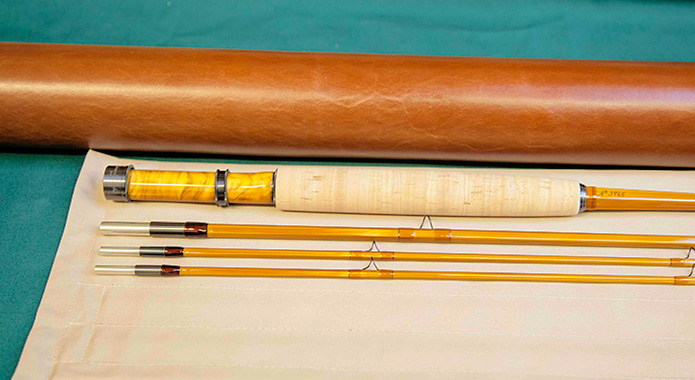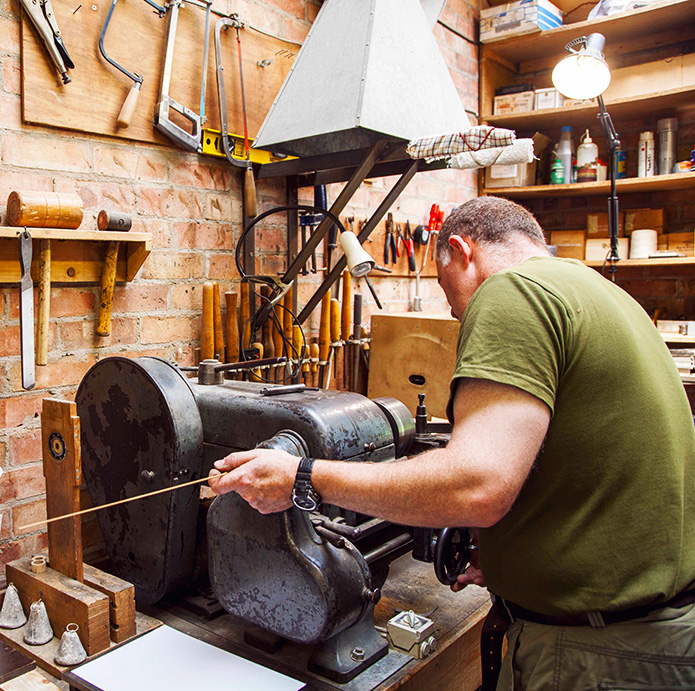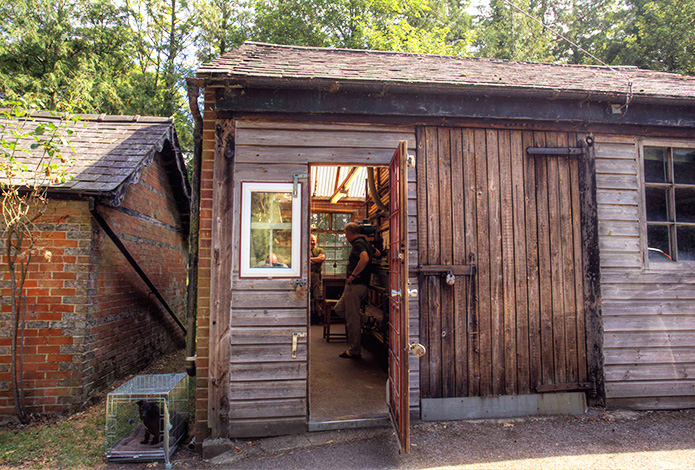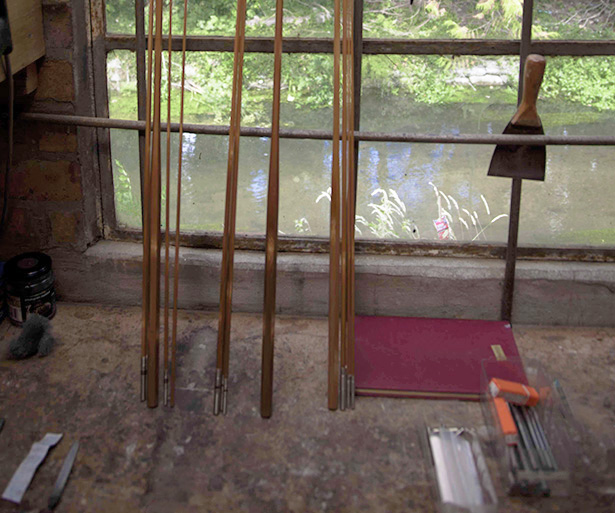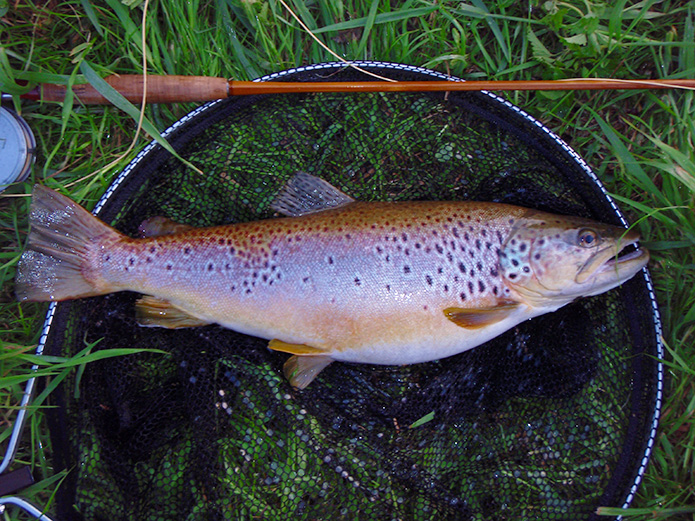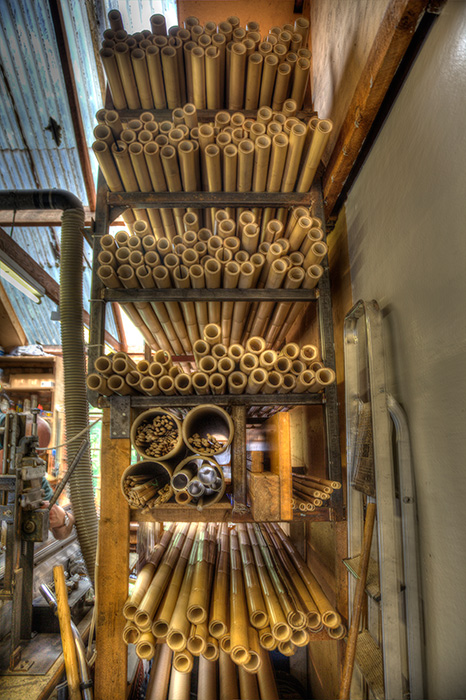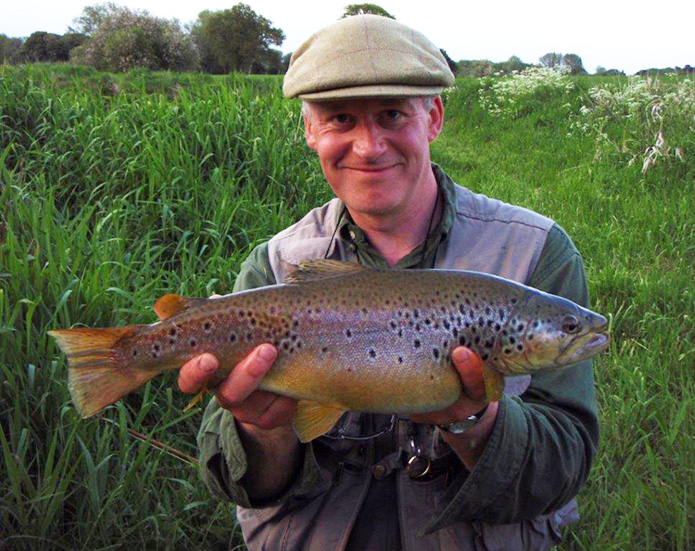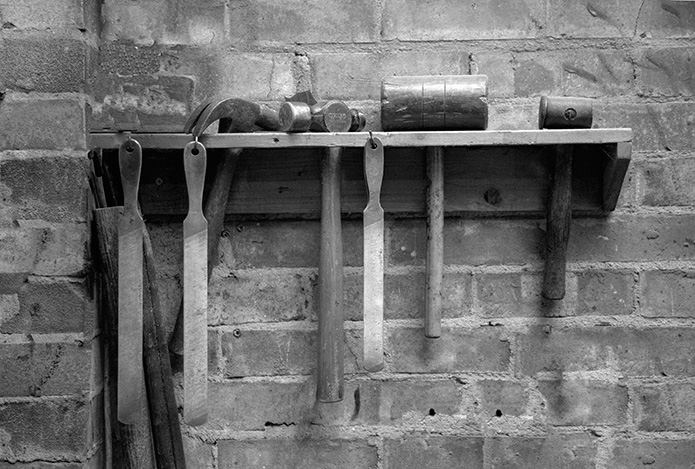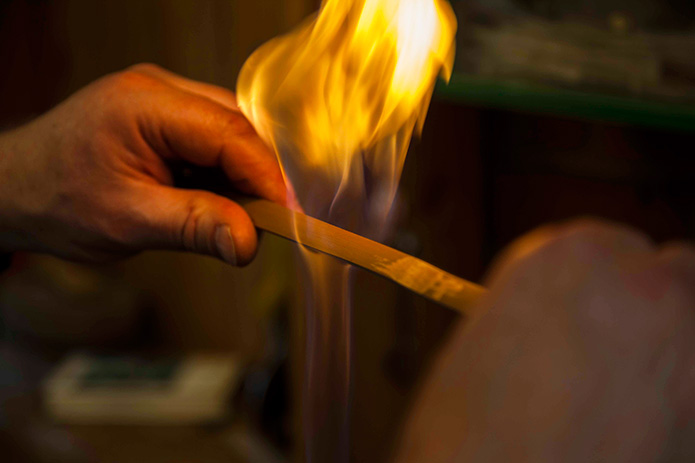
If you walk into any angling shop, the world over, there will be a sea of mass-produced carbon-fibre fishing rods, racks and racks of them, light-weight, space-age, efficient, and yet, inevitably, soulless. However, unbeknown to many, there are still in existence, and still being crafted, the natural version; the split cane rod, whittled from bamboo, Tonkin cane, which would have been the only rod, fifty years ago.
Recently, there has been somewhat of a revival in high quality cane fishing rods, patiently and skilfully crafted by hand from seasoned bamboo. Many believe that the whole fishing experience is enhanced when using a tool made from natural materials, looking totally at home on the river bank – in fact, it is not unheard of to have a bird cheekily perch upon the end! A simple, wholesome and humble invention, the timeless fishing rod has been in existence since time immemorial, ever since man fashioned a stick to help him catch fish, and the soulful character of a classic split cane rod is thought by many a fisherman to be the perfect trusted companion to share their peaceful solitude of the riverbank.
Practically speaking, the split cane is both strong and flexible, casting exquisitely and curving temptingly, sensitively and tactilely transmitting the fish’s movements down the rod, almost becoming, as all good tools should, an extension of your own arm. Classic old-school rods, the likes of Hardy, Allcock and B James & Son and the Americans; Leonard and Payne, can be still be found, pre-owned and pre-loved, however, the good news is, these practical works of art and natural engineering are still being produced in this all-too-modern of ages.
We are extremely fortunate to have been granted a little of a genuine split cane rod-maker’s precious time. Edward Barder, of The Edward Barder Rod Company, has kindly allowed us into his workshop to discuss how he got started in his craft, what inspires him, what makes a split cane rod so special, how he creates a new rod and his thoughts on crafts in general. We hope you enjoy reading…
ABOUT THE EDWARD BARDER ROD COMPANY
Edward Barder is world renowned within his craft, working, idyllically, from his simple workshop in a riverside mill, on the banks at the confluence of the rivers Kennet and Lambourn in Berkshire. Also, working alongside Edward is his assistant, and friend since they were young men, Colin Whitehouse; both of them keen and accomplished fisherman, totally in-tune, therefore, with what makes the perfect fishing rod; developing, testing and refining their rods in the famous chalk streams of the locality – nice work if you can get it! The son of a renowned angler, Richard Barder, and former employee of the legendary rod-makers Hardy’s, Edward, himself, is not at all an old man, as his craft with all its traditions and nostalgia would suggest, yet has a natural ability and undeniable patience to engineer and fashion the simplest of materials, bamboo, into a precision instrument; aesthetic, robust, yet at the same time extremely exacting in its usefulness.
Firstly, for those readers that aren’t familiar with The Edward Barder Rod Company, please can you describe what you do?
We make split cane fishing rods including light trout rods, salmon rods and coarse rods. Three quarters of the rods we make are fly rods, the remainder are coarse rods. We don’t make different grades of rod, just one standard grade, which is the best we can produce. We have developed a certain style of rod, which is good looking in aesthetic terms, but also well designed and engineered.
Our rods are made to order on a commission-only basis based on the range that we produce, so it isn’t usually possible to buy one ‘off the shelf’. We always ask or advise the client what type of rod would best suit them, and we do provide subtle options of choice such as colour of whipping silk, handle shape etc..
We used to have turnaround time of 16 weeks from initial order to finished product when we first started, but now we’re holding steady at two and a half years, which is purely down to demand. What determines the turnaround time is our output capabilities – we expect to finish about 25 rods each year, maybe 30 at a push. We used to make more in the past, but that was pre-internet and pre-email, which absorbs a lot of my time now.
We make virtually all parts of the rod here, so that we are completely in charge of supply, quality and design. We used to buy in certain parts, such as ferrules, but we took the decision years ago to equip ourselves to be independent. Now, the only things we buy in are rod guides [rings], but even then we customise them ourselves, rubber butt caps for our coarse rods, and leather rod bags, which are made by a local lady.
Can you explain why carbon fibre rods have become so popular in recent decades but why there is still a role for split cane rods today, and what the major differences are between the two and their different qualities?
Split cane was the pinnacle for rod making for nearly a century. After the Second World War though, fibreglass appeared and before too long these rods were functionally comparable to split cane; they were hard to break, waterproof and people really embraced them. For the manufacturers it made sense too, as they took little labour to produce and they could be made in great volume.
It became quickly apparent that fibreglass was on the rise, and split cane on the wane. With the lessening of demand for split cane, their quality started to decline as manufacturers devoted more effort to their fibreglass line of rods, so by the 1960s and 70s, the main suppliers were producing feeble versions of the cane rods they had made in the immediate post-war period. Some rod makers, such as Hardy’s in the UK and Leonard in the USA, persevered with split cane even in the face of logic.
The situation was exacerbated in the USA as they had a trade embargo with China, and they couldn’t get hold of essential supplies of bamboo. This wasn’t a problem for the British, as they could still receive supplies from Hong Kong, which was a British territory. The Americans were forced to embrace fibreglass, whether they liked it or not, and they had pretty much given up on split cane by the early 1970s.
Carbon fibre was the natural progression from fibreglass, and by the late 1970s/early 80s, high quality carbon fibre rods were being produced. By this time, even Hardy’s had effectively stopped making split cane; they had held out for a long time, but they took a pragmatic decision to wind this side of the business down.
There was one thing that kick-started renewed interest in split cane rods though: a book by Hoagy B Carmichael and Everett Garrison ‘A Master’s Guide To Building A Bamboo Fly Rod’ written in the late 70s. The craft-orientated fishermen out there (and there were still a number of them) heard about the book and it showed them that a determined amateur could build a high quality split cane rod. Everett Garrison was a structural engineer by profession with a formal training which he applied to the mechanics of split cane rod making. As he was a fanatical chap, he didn’t want to make an okay rod; he wanted to make a precision instrument with purpose-built equipment of his own design.
Split cane rods will always hold a place alongside carbon fibre as long as they are well designed and well made, and they’re of a weight and length to suit modern tastes. The strength/weight ratio for split cane rods means that trout rods of 9’ or shorter, or salmon rods of 12’ or shorter, stand up to the best carbon fibre rods, but beyond these lengths carbon fibre is better.
Our split cane rods are made with closer engineering tolerances than many carbon rods, designed with as much technology, and tested as precisely. Our rod blanks, for instance, are milled to within +/- 1000th inch tolerances. The tools and equipment we use may be older than those used in a modern factory, but they’re no less precise or serious.
Split cane is now only a minor player in the rod market, but it’s firmly established and has come back from the dead. There is a significant craft following for split cane rods in the USA, and in the UK they’re becoming increasingly popular as fisherman accept that you can make a really good rod out of split cane. If you took a group of really keen, relatively affluent fisherman in the US, I would estimate that at least one rod in their collection will be made from split cane.
How did you get started and who would you say has inspired and influenced you the most in your work?
As a child, I had access to my father’s collection of fishing rods, which contained both split cane and fibreglass. My brother and I would go off to fish, sometimes electing to take split cane rods, sometimes fibreglass; whilst there was no prejudice as to which to use, I preferred split cane on the purely emotional basis that it looked and felt nice. When I was a very young man, my father gave me a rod that my mother had given him when they got engaged. Its tip was broken so, with the help of a friend’s father who had been a keen amateur rod maker, I made a replacement. In those days it was still possible to buy things like ferrules from the local tackle shop. I bought the few tools required and avidly read Colonel Lawton-Moss’s book How To Build Your Own Split Cane Fishing Rod.
From those first steps I became an amateur split cane rod maker whilst managing a tackle shop near Newbury. My fist commission, for an 8’ trout rod, was from some people I knew slightly. It didn’t go unnoticed while I was working on it and via the grapevine the forerunner of The Barbel Society asked me to make some rods for them; it became a paying hobby, especially during the two years I worked for Hardy’s in Pall Mall.
I sensed whilst working at Hardy’s that there was potential to embark on a full-time career making split cane rods. There were a few people at the time writing about split cane, such as Chris Yates in the UK and John Gierach in the USA. There seemed to be a latent market that wasn’t being supplied, particularly for coarse rods, where were virtually impossible to buy. My father suggested I leave Hardy’s and follow my heart, which is what I did, aged 24.
Now I’m in my late 40s; looking back, my earliest literary influences were Col Lawton Moss’s ‘How to Build Your Own Split Cane Fishing Rod’ and the aforementioned Garrison book which I devoured. It remains a brilliant book.
The combined influences of being in the fishing tackle trade, seeing plenty of Hardy rods while working for them and getting to meet and hear of firms such as Cliff Constable, Partridge of Redditch, Chapmans of Ware, Olivers of Knebworth, Thomas & Thomas in America (a key split cane revivalist firm) were very important for me. At Hardy’s customers would come in asking if we could mend their rods, and they were sometimes by the top American and European makers, such as Leonard, Payne, Goodwin Granger, Winston, Pezon & Michel, FE Thomas et al, Not only did I see these fine historic rods, but occasionally I got a chance to fish with them. It’s only when you see and feel the best that you know what to aim for when making your own rods. 99% of people will never experience this, and it was my good fortune that I had the opportunity. It would be hard for someone to do this now as times have changed.
I’ve always been inquisitive, and slowly assembled quite a library of historic rod-making books, which has helped to build up a picture of what is possible within my craft. I’m a complete fishing nut too; fishing is my hobby as well as my job. I use the rods that I make, and this certainly helps me in my work, as I’ll alter a rod’s design if I notice something that could be improved upon; I’m very self-critical in that respect.
The need to succeed is a powerful influence on me. I’m constantly striving to do things more efficiently, but without cutting corners.
How do you select your materials for making the rods and where do you source them from?
All of the materials that we use have to be of the highest quality. Our Tonkin cane comes from a very remote and wild area of China and we buy it from a specialist who selects it very carefully for the rod building trade. As a natural crop, there are good and bad vintages, depending on weather patterns, the site, and overall health of the area in which it grows. Our agent, who is based in Seattle, is determined and resourceful, and goes out there twice a year and stays with the farmers, working flat out for 2 weeks, selecting bamboo specifically for rod makers, picking it up, rolling it around, looking at it from all angles, and measuring diameter and heft. The poles are properly handled, seasoned and then shipped wherever they need to go. A bamboo pole suitable for rod making is classed a “grade-A” pole, which has to meet certain standards for colour, size, straightness, heft and cleanliness.
Occasionally it’s been possible to buy bamboo from retired rod makers. These caches can turn up in strange places – eighteen months ago I viewed (but didn’t buy) 300 bamboo poles that once belonged to Sharpes of Aberdeen. They were in a barn on a cider farm in Herefordshire.
Our handles are made from the best Flor-grade cork from Portugal, which is now extremely expensive. Each cork ring is cut in half, and we only use the best half of each ring. We use English-made Pearsall’s silk for the whippings that secure ferrule splints and guides. The reel seats are made from highly figured seasoned olive wood. It’s very stable and dense, so can be machined and engineered precisely. The handle fittings and ferrules are made from 18% nickel silver, which machine ourselves.
We buy in guides (rod rings) the feet of which we grind to our liking and re-bronze partly for aesthetic reasons, and partly because they could scare fish if left bright shiny. The varnish we use is a very high grade of yacht varnish. It isn’t easy to apply really well and it cures quite slowly, but we achieve a pretty flawless finish and it does last for decades. Our rod bags are made to measure by a local seamstress and the leather cases are made by the person in charge of saddlery at the Royal Mews, who uses only the best English full grain cow hide, which is entirely hand stitched.
Can you describe how you make your rods so that readers can learn what the craft of traditional split cane rod-making entails?
The fundamentals of split cane rod making haven’t changed for generations. The rod blank is made from a Tonkin bamboo pole, split into strips using a knife and mallet. Each bamboo pole has knots at intervals. The bamboo is tempered over a flame and straightened. We use the heat to temporarily make the bamboo soft so it can be re-set in its straightened form as it cools. The knots are straightened and pressed using the same heat source, which is far better than weakening them by using a sanding machine.
Heating the bamboo drives a lot of moisture out of it. If it isn’t removed the bamboo will be ‘soggy’ and won’t recover properly from being bent. Working the bamboo carefully over a low pressure open flame is the way we do this. During heat treatment the bamboo shrinks, becomes denser and more stable
Once all the preparatory work has been carried out on the bamboo strips, they are turned into tapered triangular strips using a milling machine. When glued together they form a hexagon, with the strongest fibres on the outside.
The engineer and rod-maker Everett Garrison concluded that the strongest form of fishing rod is hexagonal, which is good enough for me, and all of our rods are made this way.
The strips are run through the machine to ensure the correct taper depending on the design. The finished strips are soaked in a special heat and waterproof glue and then spirally wrapped twice in a binding machine to ensure a strong, tight fit and a true, straight rod. This gluing is done under pressure to squeeze all the excess glue out.
Once the glued ‘blank’ is fully seasoned and straightened the outer shell of the bamboo and any glue residue is very carefully sanded off. Then the nickel silver ferrules are fitted, the cork handle is turned, the reel seat fitted and the guides are whipped on.
It is then varnished to create an immaculate finish. One of our dealers quipped that our attention to detail is ‘insane’, which we took as a great compliment.
What are the key skills that are required for your craft?
The skills for rod making are fairly unique. We’re cousins of musical instrument makers and cabinet makers, but that’s all; the skills aren’t immediately transferable.
There aren’t any apprenticeships anymore; Partridge of Redditch were the last to offer one, but they’ve sadly stopped making rods. There are courses that you can attend in the USA though.
For the budding amateur, the rod design process needn’t be too much of a hurdle, as there are plenty of designs out there that can be copied. To carry all the physical tasks of making the rod, woodworking skills would be useful. You’d need a lathe for handle turning and some metalworking, although you can buy reel seats and ferrules from specialist suppliers. Whipping on rings, varnishing etc, can be learnt quite easily. I’d go as far to say that 90% of people could probably make a rod. Like most people could make a cabinet, but it doesn’t mean they will all threaten Lord Linley!
If you have the innate skills, then determination to improve is what will set you apart from others. Patience is also of paramount importance – we’re using natural materials and sometimes things such as bamboo straightening or varnishing, can’t be hurried. Time and patience will be repaid in the long term. Finally, being resourceful is very important; being capable of making or adapting machines and equipment is often necessary.
Who are your typical customers?
I suppose they are people who are genuinely besotted with fishing; people who have a strong aesthetic desire and appreciation of craftsmanship. Due to the fact that we don’t advertise much, most of our customers come across us by recommendation and word of mouth. When we do advertise, it’s likely to be in Trout & Salmon, or possibly The Field or Country Life.
It’s normally people who want to treat themselves or have a rod given to them as a present from their partners, or the companies they work for. We receive a lot of orders as 50th birthday presents; due to the long lead time, we provide a certificate when the rod is ordered, and this is given to the recipient, who then waits patiently until they are two years older and their rod is ready. Gratifyingly, we still receive a lot of orders from people who simply want to own a quality split cane rod and have saved up their money; people without huge disposable incomes.
A lot of craftsman we speak to have trouble sourcing new quality tools and equipment for their work, and in many case have to resort to vintage tools, or even make their own. What tools and equipment do you use for your work and where did you source these from?
When starting out the tools needed for amateur rod-making are few, and amateurs are well served in the availability of tools, such as block planes and hand planing forms. When I first set up, I quickly realised there was a big difference between being an amateur and professional rod maker, and I needed to acquire specialised equipment, such as my bamboo milling machine, bamboo drying oven, a lathe for turning handles, a glue binding machine, and precision metal lathe.
As these machines are so specialist, we’ve had to make some of them ourselves or have them made. I was lucky and managed to buy some second hand equipment. I’ve come across rod-making equipment dating to the late 19th Century. I was offered a fantastic original milling machine from Allcocks, but it was 18’ long, and just too large for our workshop, so I declined. When I started out I managed to secure some second-hand equipment from Cliff Constable of Bromley, but it was all stripped down without any instructions, so it was one big jigsaw puzzle to rebuild it. It was good experience for us though, as we really needed to understand the machinery inside out. In fact, we used these machines as inspiration for future machines that we’ve had made.
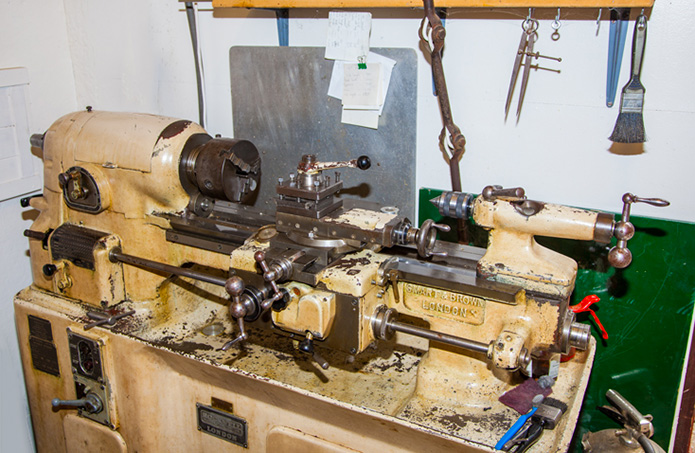
My advice for anyone looking to establish a workshop would be to be cautious and don’t get too carried away with spending money on machinery that you might not need.
Can you describe your work space and in what way does it influence your work?
Our workshop is in the grounds of Ham Mill, on the river Kennet. It’s an area steeped in fishing history; the confluence of two famous chalk streams – the rivers Lambourn and Kennet – is at the end of the garden, and we’re basically surrounded by river.
The Piscatorial Society, one of the most venerable fishing clubs of all, fished the waters here. There are several fish in their collection that were caught from the weir pool next to the mill.
The area certainly influences us. Our workshop was previously a generous double garage, and provides barely enough room for all our machinery and materials, so we have to be resourceful with our use of space, and make sure we don’t keep bumping into each other! The fact that it’s a quiet spot means there are few outside distractions, so we can get on with what we need to do. We put all our rods through their paces by testing them on the stream behind the workshop, which is very handy.
When you design new rods, are you re-working and improving traditional designs from the past, or creating new contemporary designs?
I used to re-work traditional designs, but over the years I’ve focussed on creating new designs. All the rods that I created collaborating with Chris Yates in ‘A Passion For Angling’ were designed from scratch, but I still make Richard Walker Mark IV carp and Avon rods to the designs he published.
If I’m altering an existing design, then I tend to make very subtle changes. Otherwise it’s a bit like cutting a child’s hair – you can keep snipping away hoping for a straight line but if you’re not careful you can end up making an irretrievable mess.
A lot of my early rods were inspired by Everett Garrison and others but now I design rods from scratch, according to my views on the mechanics of rod building and design, and my experience of using the rods we make. Any changes we make to our designs are always experience-led and gradual.
Can you provide any advice for anyone wanting to take up a craft similar to yours, or traditional crafts in general?
On a general basis, I’d suggest don’t give up your day job and only proceed to a full-time change of career with extreme caution. If you have time, really delve into it before making a commitment. Make the transition from part-time craft to paying hobby before turning it into a full-time career; the last thing you want is to turn a hobby that you love into a business which you end up hating. There’s a vast difference between doing something for your own amusement, and doing something professionally.
You need to work out how much you can live on and analyse the paying realities of the craft and analyse the overheads and fixed asset costs associated with it. In my experience, treble overheads and reduce earnings by a third!
As a career, you need to forget that this was your hobby; you need to apply the same rules you would for any new business, as cold, hard realities apply. Look at projected sales, and then look at them again. Look at tax implications, margin analysis etc. Look at your competitors, and analyse the size of your market and who is supplying it already. Measure your work against people who are universally acknowledged as the best in their field and examine your conscience to know you can produce high quality work on a consistent basis. When I went into business, it was a market where supply was not being met. I was quite lucky; nowadays, that might not always be the case.
Be incredibly tight with stock control – make sure you don’t tie up money in materials that you aren’t using. Make sure you can buy materials reliably if you’re a manufacturing business. If you can, work from home. Failing that try to find premises that are affordable and on favourable terms vis a vis annual rent, rates and terms of lease.
I would always advise someone thinking about setting up to talk to someone with experience of business, who knows how to operate a company, as it’s the same set of commercial rules and realities that apply to a craft business as any other. Ensure that you don’t bankrupt yourself in the process, and make sure you can get back into another job if the worst-case scenario happens.
If you can make a success of a craft-based business, it can be incredibly satisfying, For us, nothing beats seeing the pleasure on the face of the client when you hand them a rod that you know that they’ve saved up for and will cherish all their life. It is also satisfying working for yourself, being in control of your destiny.
With this demand for your rods, and the long waiting lists, are you tempted to increase production, and if so, would you take a production-line approach, or artisan, with each person responsible for the production of their rod from start to finish?
It would be nice for us to make rods more quickly as it would reduce the waiting list, but we’re not tempted to increase production. We doubt that we can fundamentally refine the process any more – having done it for 23 years. The only way would be to hire additional labour to assist us.
People have advised us that we should take on an apprentice. The problem is that there are numerous procedures in rod making, each requiring particular skills, and it would take an inordinate amount of time to take someone on and train them up in all aspects, and we couldn’t afford the decrease in productivity whilst teaching them what to do.
In many ways it’s the same issue that owners of cottage industries faced hundreds of years ago. The Guv’nor couldn’t afford the time spent teaching an apprentice, as it would bankrupt him, so the family of the apprentice would pay for their apprenticeship. After a few years the apprentice would qualify within the particular Guild and could prove that he or she was productive and skilled at their trade. At that point, the individual is a fully functional, profitable asset to the business.
The only way it would work in our business is if someone came to us who was a gifted amateur and showed us what they’d achieved so far and could somehow persuade us that they could change all our fortunes for the better. It’s unlikely that there are many such people out there. In any case I don’t think there’s enough room for a third person in the workshop and we don’t intend moving. Even if we did make more blanks, I wouldn’t have time to varnish them all.
Long ago, split cane used to be the mainstream material and was made in high volume, but the quality wasn’t always the best. There’s no place in the today’s connoisseur-led market for high volume, low quality split cane rods, and it would be dangerous to apply practices that worked historically for bigger companies to the artisan firms of today.
What do you feel the future holds for traditional split cane rod making?
I feel that the future is assured for split cane rods, because of a combination of the serious and extensive amateur scene interested in hand-crafted rods, and the fishing population as a whole is more and more in touch with their heritage and the environment. People who are interested in wild fishing in natural, healthy water are more environmentally concerned, appreciate aesthetics and are looking for a more cerebral experience in their fishing. Split cane rods fit well into this mind-set.
As for making a career from split cane rod making; it is debateable whether it offers a prospect for more than a handful of people.
Thanks to Edward Barder for taking time out of his busy schedule to answer our questions. For more information on split cane rods by The Edward Barder Rod Company, or if you’re considering commissioning a rod, please visit Edward’s website by clicking the link below:

